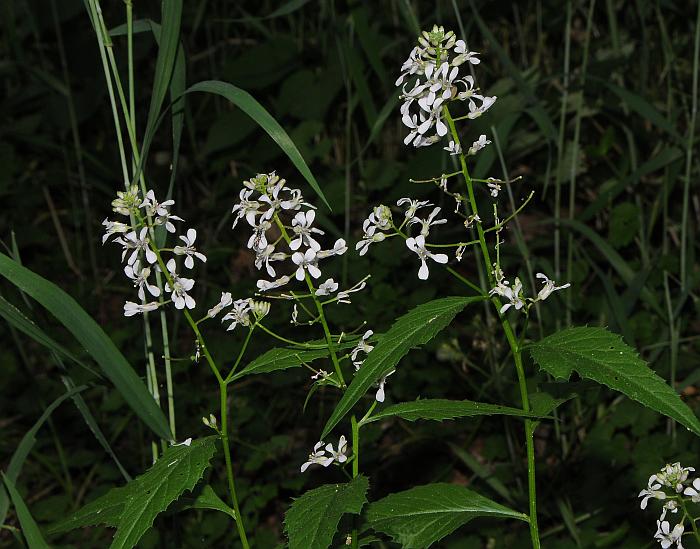Iodanthus pinnatifidus (Michx.) Steud.
Purple Rocket

Native
CC = 7
CW = -3
MOC = 55
© SRTurner
Iodanthus pinnatifidus (Michx.) Steud.Purple Rocket | |
 |
Native CC = 7 CW = -3 MOC = 55 |
© SRTurner |
|
Family - Brassicaceae Habit - Taprooted perennial forb. Stems - Erect, to 80 cm, usually unbranched, usually glabrous or nearly so.
Leaves - Alternate and sometimes basal, 4-15 cm long, the lower leaves petiolate, the upper ones often sessile, sometimes clasping the stems with rounded auricles, the leaf blades lanceolate to ovate-lanceolate, the lower leaves frequently pinnately lobed or divided, the margins toothed, glabrous.
Inflorescence - Terminal and axillary racemes elongating in fruit to 30 cm. Pedicels slightly elongating in fruit to 1 cm, tuberculate, spreading.
Flowers - Sepals 4, 4-6 mm long, ascending, oblong. Petals 4, 8-14 mm long, not lobed, white to light purple. Stamens 6, 4 large and 2 small. Filaments glabrous, lilac at apex, whitish near base, to 8 mm long. Anthers purple, 1.2 mm long. Styles 1.5-2.0 mm long. Ovary purple, glabrous, 7 mm long, terete.
Fruits - Siliques 2-4 cm long, ascending to spreading, straight to slightly arched upward, linear, terete, not beaked except for the persistent style, each valve with an indistinct midnerve, usually covered with minute, transparent papillae, dehiscing longitudinally. Seeds in 1 row in each locule, 1.0-1.5 mm long, oblong in outline, somewhat flattened, narrowly winged at both ends, the surface with a netlike or honeycomb-like pattern of ridges and pits, reddish brown.
Flowering - May - June. Habitat - Bottomland forests, streambanks. Origin - Native to the U.S. Other info. - This plant is found in bottomlands throughout most of Missouri, and also occurs throughout the central U.S. Midwest. It is easily recognized by its showy inflorescences of near-white, 4-petaled flowers, which contrast with the usually heavily shaded areas favored by the plant. It is a textbook member of the Brassicaceae, having 4 distinct petals, 4 distinct sepals, and 6 distinct stamens. The plant is common in the habitats mentioned above but is frequently found growing in association with other, less friendly alluvial plants such as Laportea canadensis and Toxicodendron radicans. Photographs taken in the Ozark Scenic Riverways, Shannon County, MO., 5-24-03 (DETenaglia); also at Pacific Palisades Conservation Area, Jefferson County, MO, 5-10-2012, and Shaw Nature Reserve, Franklin County, MO, 6-26-2013 and 5-25-2014 (SRTurner). |